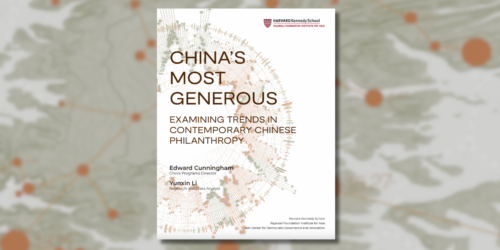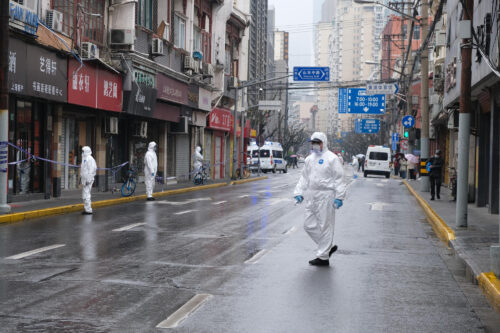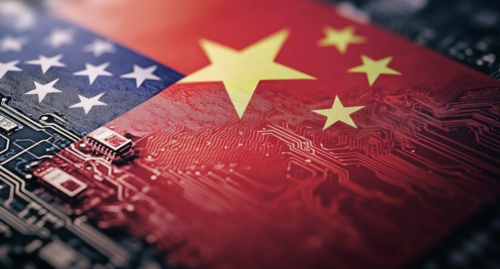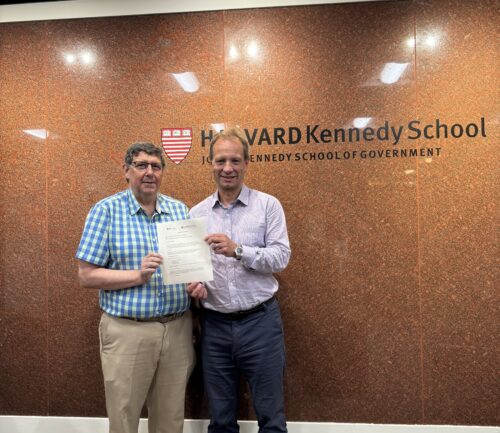With cities across China seeing demonstrations aimed at the country’s stringent “zero COVID” policy, we sat down with Tony Saich, director of the Rajawali Foundation Institute for Asia at the Kennedy School’s Ash Center for a conversation about political protests and how the leadership in Beijing views this challenge to its authority. Saich, an expert on China’s leadership and state institutions, noted the remarkable nature of the protests and suggests that “the people have had enough.”
Ash: Given that China’s harsh “zero COVID” measures have been in place for some time, what was the catalyst for this wave of protests?
Saich: The immediate catalyst was a house fire in Xinjiang, in the northwest of China, which caused the death of at least 10 people. Demonstrations began there as people felt that the COVID lockdown had prevented help getting to those in the building. This event has tapped into the deeper frustration about the unpredictable lockdowns caused by the zero-COVID policy. This is exacerbated by the confusion around current policy and the uncertainty on when a lockdown might occur. The protests’ link to the Xinjiang fire is shown by the fact that the major demonstrations in Shanghai took place around Urumqi Road (Urumqi is the capital city of Xinjiang). The protests have now expanded to many cities across China, including Beijing, Chengdu, and Wuhan, where the initial coronavirus outbreak occurred at the start of the pandemic.
Given the pervasive censorship and tight control over public spaces that Chinese authorities maintain, how remarkable is it to see protests this large and across so many cities simultaneously?
Demonstrations occur every day across China. However, such demonstrations are almost always confined to specific local problems, such as unpaid wages. This is highly unusual as the demonstrations have not only spread across the country, but also have one single cause: frustration with the government’s zero-COVID policies and the unpredictable nature of the lockdowns. People have had enough. The demonstrations even occurred on the two campuses of Peking and Tsinghua universities. It is remarkable to hear that some of the chants have included the call for Xi Jinping and the Chinese Communist Party to step down. Some of the demonstrators have adopted earlier tactics used in the 1989 demonstrations, chanting party slogans such as “Serve the People” and singing parts of the song of the Communist Internationale.
How will China’s leadership respond to these growing demonstrations? Are they likely to result in a modification to the country’s anti-COVID measures?
The party had already suggested, in a very confused manner, that it would modify its policy, increasing the frustration, I think. How the leadership will respond will depend on how long the demonstrations last and whether they exhibit further anti-regime sentiment. They will follow their usual songbook. Students are being told to go home, some figures will be (and some already have been), arrested in order to deter others. I think the party will wait and hope that the demonstrations fizzle out and then the party can remove those who remain and start a search for what they will call ringleaders with ulterior motives.
How is Xi likely to frame the motivations behind the protestors?
This is hard to say. He will not have been pleased to hear calls for him stepping down. I think that the party will stress again that the primary objective of the policy is to save people’s lives and contrast this with the higher levels of deaths in the West, especially in the United States. One would expect the refrain to dominate that a “handful of people” have used the situation to exploit it for ulterior motives. Most of the protestors will be judged to have been acting in good faith but need to appreciate the value of the policy approach and how it is born from concern for the people’s well-being. The policy is so closely identified with Xi Jinping that it is difficult for the authorities to shift course too radically or too quickly. That said, this is a huge challenge and must have taken them by surprise. I think they will try to shift to bringing more predictability to the process, with clearer guidelines on when lockdowns should occur and how they should be managed. At the same time, they will boost the program for vaccinations, which has had a poor roll out. China has invested most heavily in mass testing and developing quarantine centers, which, of course, make money for those involved. They have done less to build up other public health resources that do not turn a profit.
If, as expected, Xi points the finger at malevolent foreign actors, how should the international community respond to the growing protests?
Blaming foreign interference is a normal approach for the party, but I have not heard that that has happened yet. International response will depend on whether the protests continue to grow and the direction they take. It will also depend on the authorities’ response. If this turns to a violent repression, then the international community needs to express its support for peaceful demonstrators, who are responding to the party’s own policies and poor implementation.
If these demonstrations persist, what would trigger a change in the government’s response, and how could we expect the situation on the streets to change?
If the demonstrations fizzle out, the party will not need to take drastic measures. If they persist and turn even more critical of the system rather than of the mismanagement of COVID, the authorities will adopt previous measures of control: blaming ringleaders for inciting unrest, arresting some as a warning to others, and eventually a bout of swift violence to deter people from coming out to demonstrate further. If this is the path that is followed, which is by no means certain, it is hard to predict the response. The overwhelming power of the state in China, once mobilized, is formidable and most might decide to retreat.




